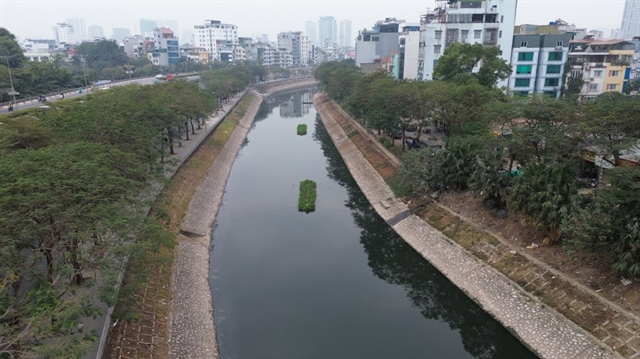 Society
Society


|
| Reviving the polluted Tô Lịch River is urgent task for the Hà Nội authorities. Photo chinhphu.vn |
HÀ NỘI – Deputy Prime Minister Trần Hồng Hà has directed the investment in building an emergency water supplementation project from the Hồng (Red) River into the Tô Lịch River.
Based on the proposal of the Hà Nội People's Committee, regarding a policy for building the emergency water supplementation project for the rivers and opinions from related ministries, the Deputy PM asked the municipal authority to address the root causes of pollution in the rivers. He stressed that restoring rivers, especially the Tô Lịch River, to bring it back to environmental quality was a priority for improving the landscape and local culture, as well as to protect public health.
First, the Hà Nội People's Committee should immediately implement the project to supplement water for the Tô Lịch, especially since 100 per cent of wastewater along the river has been collected and directed to the Yên Xá Wastewater Treatment Plant, with the treated water no longer discharged back into Tô Lịch.
The transfer of water from the Red River should be carried out alongside reviewing plans and implementing synchronised measures to collect all wastewater along the rivers, managing rainwater, improving urban infrastructure and enhancing the economic, cultural and environmental values of the riverbanks.
Based on the clauses of Law on Construction and Law on Public Investment, the Hà Nội People's Committee has full authority to decide and implement urgent public investment projects under its management, aiming to complete this project by the autumn.
For emergency public investment projects, the committee must direct its departments to finalise all economic and technical plans ensuring the project's economic efficiency, sustainability and preventing loss or waste of public property and state budget funds.
The Deputy PM emphasised the need to research options for sediment filtering and water clarification for the Red River to reduce sedimentation, using treated water effectively and consider supplementing water back into Tô Lịch instead of just redirecting it to the Red River.
Impact assessments and solutions to ensure the safety of technical infrastructure at the water intake sites and along the pipeline route must also be conducted.
The ministries of Agriculture and Rural Development, Construction, and Natural Resources and Environment are assigned to co-ordinate with and guide the Hà Nội People's Committee in promptly finalising procedures related to dykes, construction, water resources and the environment to ensure the project's objectives, timeline and compliance with legal regulations.
Regarding the water supplementation plan from the Red River to Tô Lịch River, Hà Nội previously agreed on a route that directs water pipelines from the dyke culvert along Võ Chí Công Road, to the Tô Lịch River intake point, at the culvert near Hoàng Quốc Việt Road.
The city plans to build a pumping station with a capacity of 3-5cu.m per second at the Red River alluvial plain in Phú Thượng Ward of Tây Hồ District, including a pumping station, a suction basin, a transformer station and management office.
Water will flow from the pumping station along internal roads within the alluvial plain, through the Red River dyke under Nhật Tân Bridge.
At the approximately 45-m section through the dyke, Hà Nội will excavate the dyke, construct a box culvert and install pipes inside the culvert.
Along Võ Chí Công Road, there will be a water distribution outlet directing water through Lạc Long Quân Street to Đầm Bảy Lake for treatment before flowing into West Lake.
For technical solutions, Hà Nội plans a water supplementation flow rate of three cubic metres per second for the Tô Lịch River and West Lake.
Three weirs are planned at Cống Mọc, Cầu Dậu, along with one at the junction of Tô Lịch River and Kim Ngưu River.
Hà Nội is committed to completing the project before September this year. VNS

.jpg)


.jpg)